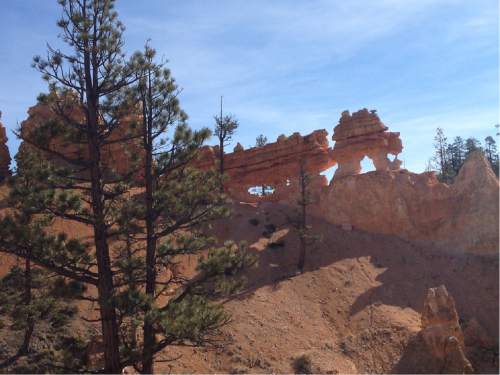This is an archived article that was published on sltrib.com in 2015, and information in the article may be outdated. It is provided only for personal research purposes and may not be reprinted.
It looks like Bryce Canyon's "turtle" has lost its head.
A critical piece of the redrock hoodoo on the Mossy Cave Trail is missing.
The national park's formations are famous across the world as mysterious natural wonders that create color-splashed settings for photographers. But they're also fragile, as a recent photo published in The Salt Lake Tribune's weekly "Where Is It?" feature revealed last week.
A photo of the unique formation, commonly called the Dragon or Turtle, drew a large number of entries. But just one person noticed a discrepancy.
"The picture in the paper is an old one, as the head of the 'turtle' is now missing," wrote Kristine Berg of Salt Lake City.
She attached a photo she had taken. And Berg's picture clearly shows the head of the turtle has fallen away from the rest of the formation.
The Tribune's picture was taken on Presidents Day 2014. Berg snapped her image on Presidents Day 2015.
Bryce Canyon officials were not aware of the change when contacted Monday.
Interpretive park ranger Kevin Doxstater said the 75 to 125 pounds of rock likely broke off naturally due to erosion — perhaps during wintertime freeze-and-thaw cycles, when water seeps into cracks in the siltstone and limestone. Hoodoos throughout the 35,000-acre park are constantly changing.
"It's just further proof of what is happening here," Doxstater said. "Most of what happens is at a slow pace we can't detect. Every once in a while, we get a significant event like this one. It's a cool thing to see."
More than 250 people entered the "Where Is It?" contest when it hit the sltrib.com website March 6.
Only Berg pointed out the difference; she had just made the Mossy Cave hike a few weeks earlier.
It seems likely the turtle lost its head fairly recently, Doxstater said.
"The major erosion at Bryce happens in the winter when water seeps into cracks and then freezes," he added. "We did have a big snow event on Dec. 31 and then March-like weather in January, so that would have been a good opportunity for something like this to happen."
Some people hiking below the rim at Bryce Canyon National Park on Presidents Day weekend noticed smaller signs of erosion that had caused rocks and dirt to slide down the steep slopes.
Doxstater said hoodoos can collapse any time of the year, but the damage is rarely witnessed by people. One notable event happened two years ago when visitors watched as a massive chunk of the Boat Mesa formation near Fairyland Point broke off and tumbled into the canyon.
Other famous southern Utah formations have partially or completely collapsed in recent years.
Wall Arch — 71 feet tall and 33½ feet wide — in Arches National Park collapsed in August 2008.
And 306-foot Landscape Arch, also on the Devils Garden Trail in Arches, lost a 60-foot-long and 11-foot-wide slab as visitors watched in 1991.
Now that Bryce Canyon's Turtle no longer has its head, the question is: What will they call it?
Twitter: @BrettPrettyman



